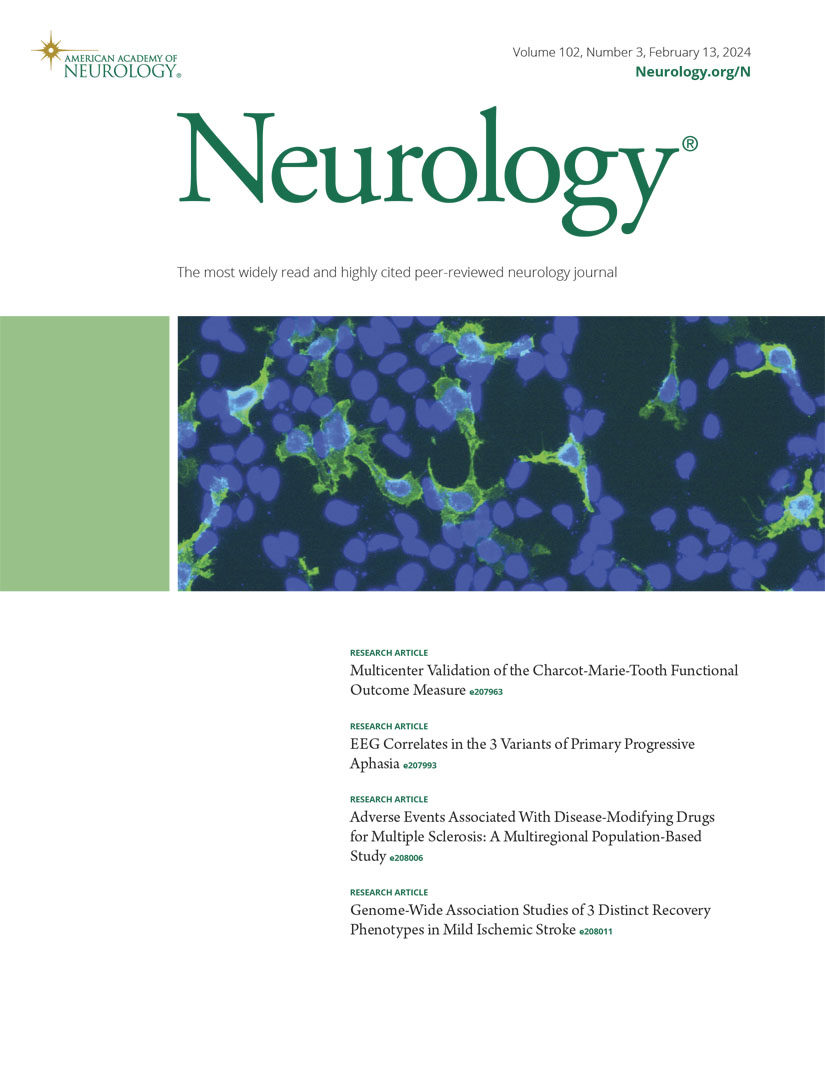Use of Antiseizure Medications Early in Pregnancy and the Risk of Major Malformations in the Newborn.
IF 7.7
1区 医学
Q1 CLINICAL NEUROLOGY
引用次数: 0
Abstract
BACKGROUND AND OBJECTIVES Maternal use of first-generation antiseizure medications (ASMs), such as valproate and phenobarbital, increases the risk of congenital malformations in offspring. Second-generation ASMs, such as lamotrigine and levetiracetam, pose less risk to fetal development, although topiramate seems to increase the risk of oral clefts. Less is known about the safety of newer second-generation ASMs during pregnancy including oxcarbazepine, zonisamide, and lacosamide. The aim of this study was to quantify the relative risk of major malformations in offspring after maternal use of specific ASMs early in pregnancy, with special interest in second-generation ASMs. METHODS The study population included pregnant women who enrolled in the North American Antiepileptic Drug Pregnancy Registry between 1997 and 2023. Data on ASM use and maternal characteristics were collected through phone interviews at enrollment, at 7 months of gestation, and within 3 months after delivery. Malformations were confirmed by medical records and adjudicated by a dysmorphologist. The risk of major malformations was estimated among infants exposed to specific ASMs in monotherapy during the first trimester of pregnancy. Risk ratios (RRs) and 95% CIs were estimated with logistic regression models. RESULTS A total of 7,311 participants taking an ASM as monotherapy during the first trimester were eligible for analysis. The mean age was 30 years. The risk of major malformations was 2.1% (52/2,461) for lamotrigine, 2.0% (26/1,283) for levetiracetam, 2.8% (32/1,132) for carbamazepine, 5.1% (26/510) for topiramate, 2.8% (12/423) for phenytoin, 9.2% (31/337) for valproate, 1.5% (5/327) for oxcarbazepine, 1.5% (4/270) for gabapentin, 1.3% (3/228) for zonisamide, 6.0% (12/200) for phenobarbital, 3.2% (2/62) for pregabalin, and 0% (0/88) for lacosamide. Compared with lamotrigine, the RR was 5.1 (95% CI 3.0-8.5) for valproate, 2.9 (1.4-5.8) for phenobarbital, and 2.2 (1.2-4.0) for topiramate. Topiramate was specifically associated with a higher risk of cleft lip. DISCUSSION Results confirm the association between maternal use of valproate, phenobarbital, and topiramate early in pregnancy and a higher risk of major malformations in the infant compared with lamotrigine. However, they do not support meaningful risk elevation for levetiracetam, oxcarbazepine, gabapentin, or zonisamide. Relative risk estimates for lacosamide and pregabalin are still imprecise.妊娠早期抗癫痫药物的使用与新生儿重大畸形的风险。
背景与目的母亲使用第一代抗癫痫药物(asm),如丙戊酸钠和苯巴比妥,会增加后代先天性畸形的风险。第二代asm,如拉莫三嗪和左乙拉西坦,对胎儿发育的风险较小,尽管托吡酯似乎增加了唇裂的风险。关于妊娠期间更新的第二代asm的安全性知之甚少,包括奥卡西平、唑尼沙胺和拉科沙胺。本研究的目的是量化母亲在妊娠早期使用特定的asm后后代主要畸形的相对风险,对第二代asm特别感兴趣。方法研究人群包括1997年至2023年间在北美抗癫痫药物妊娠登记处登记的孕妇。在入组时、妊娠7个月时和分娩后3个月内,通过电话访谈收集ASM使用和产妇特征的数据。畸形由医疗记录确认,并由畸形学家裁定。在妊娠前三个月暴露于特定的单药治疗的婴儿中,主要畸形的风险被估计。采用logistic回归模型估计风险比(rr)和95% ci。结果7311名在妊娠早期接受单药治疗的患者符合分析条件。平均年龄为30岁。严重畸形风险拉莫三嗪为2.1%(52/2,461),左乙拉西坦为2.0%(26/1,283),卡马西平为2.8%(32/1,132),托吡酯为5.1%(26/510),苯妥英为2.8%(12/423),丙戊酸为9.2%(31/337),奥卡西平为1.5%(5/327),加巴喷丁为1.5%(4/270),唑尼沙胺为1.3%(3/228),苯巴比妥为6.0%(12/200),普瑞巴林为3.2%(2/62),拉科沙胺为0%(0/88)。与拉莫三嗪相比,丙戊酸酯的RR为5.1 (95% CI 3.0-8.5),苯巴比妥为2.9(1.4-5.8),托吡酯为2.2(1.2-4.0)。托吡酯尤其与唇裂的高风险相关。讨论:结果证实,与拉莫三嗪相比,孕妇在妊娠早期使用丙戊酸盐、苯巴比妥和托吡酯与婴儿发生重大畸形的高风险之间存在关联。然而,它们不支持左乙拉西坦、奥卡西平、加巴喷丁或唑尼沙胺有意义的风险升高。拉科沙胺和普瑞巴林的相对风险估计仍然不精确。
本文章由计算机程序翻译,如有差异,请以英文原文为准。
求助全文
约1分钟内获得全文
求助全文
来源期刊

Neurology
医学-临床神经学
CiteScore
12.20
自引率
4.00%
发文量
1973
审稿时长
2-3 weeks
期刊介绍:
Neurology, the official journal of the American Academy of Neurology, aspires to be the premier peer-reviewed journal for clinical neurology research. Its mission is to publish exceptional peer-reviewed original research articles, editorials, and reviews to improve patient care, education, clinical research, and professionalism in neurology.
As the leading clinical neurology journal worldwide, Neurology targets physicians specializing in nervous system diseases and conditions. It aims to advance the field by presenting new basic and clinical research that influences neurological practice. The journal is a leading source of cutting-edge, peer-reviewed information for the neurology community worldwide. Editorial content includes Research, Clinical/Scientific Notes, Views, Historical Neurology, NeuroImages, Humanities, Letters, and position papers from the American Academy of Neurology. The online version is considered the definitive version, encompassing all available content.
Neurology is indexed in prestigious databases such as MEDLINE/PubMed, Embase, Scopus, Biological Abstracts®, PsycINFO®, Current Contents®, Web of Science®, CrossRef, and Google Scholar.
 求助内容:
求助内容: 应助结果提醒方式:
应助结果提醒方式:


